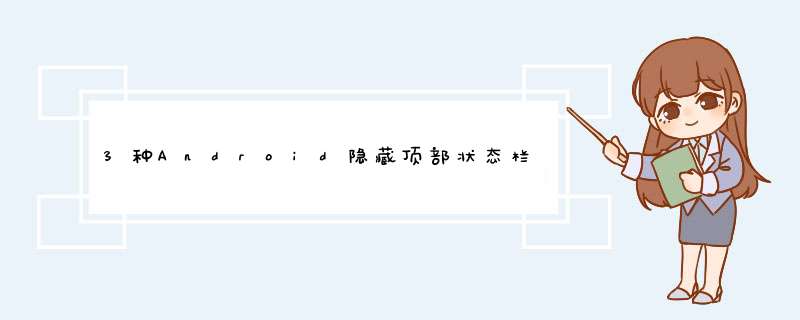
本文包含3种隐藏顶部状态栏及标题栏和一种隐藏AndroID 4.0平板底部状态栏的方法,分享给大家供大家参考,具体内容如下
方法一
public class MainActivity extends Activity{ @OverrIDe protected voID onCreate(Bundle savedInstanceState) { super.onCreate(savedInstanceState); // 隐藏标题栏 requestwindowFeature(Window.FEATURE_NO_Title); // 隐藏状态栏 getwindow().setFlags(WindowManager.LayoutParams.FLAG_FulLSCREEN,WindowManager.LayoutParams.FLAG_FulLSCREEN); setContentVIEw(R.layout.activity_main); }}方法二
<!-- 同时隐藏状态栏和标题栏 --><activity androID:name="com.ysj.demo.MainActivity" androID:theme="@androID:style/theme.NoTitlebar.Fullscreen" androID:label="@string/app_name" > <intent-filter> <action androID:name="androID.intent.action.MAIN" /> <category androID:name="androID.intent.category.LAUNCHER" /> </intent-filter></activity>
方法三
<!-- Application theme. --><style name="Apptheme" parent="AppBasetheme"> <!-- All customizations that are NOT specific to a particular API-level can go here. --> <!-- 隐藏状态栏 --> <item name="androID:windowFullscreen">true</item> <!-- 隐藏标题栏 --> <item name="androID:windowNoTitle">true</item></style>
注:
1、方法一中的两段代码要在setContentVIEw()之前。
2、方法二只能同时隐藏状态栏和标题栏。
3、方法一和方法二都只应用于单个Activity。方法三应用于整个程序。
对于运行AndroID 4.0以上系统的平板电脑,以上三种方法都不会隐藏屏幕下方的状态栏,须做如下处理。
public class StartupActivity extends Activity{ @OverrIDe protected voID onCreate(Bundle savedInstanceState) { super.onCreate(savedInstanceState); setContentVIEw(R.layout.activity_startup); /* * 隐藏运行AndroID 4.0以上系统的平板的屏幕下方的状态栏 */ try { String ProcID = "79"; if (androID.os.Build.VERSION.SDK_INT >= androID.os.Build.VERSION_CODES.ICE_CREAM_SANDWICH) ProcID = "42"; // ICS // 需要root 权限 Process proc = Runtime.getRuntime().exec(new String[] { "su","-c","service call activity " + ProcID + " s16 com.androID.systemUI" }); // WAS proc.waitFor(); } catch (Exception ex) { Toast.makeText(getApplicationContext(),ex.getMessage(),Toast.LENGTH_LONG).show(); } } @OverrIDe protected voID onDestroy() { // Todo auto-generated method stub /* * 恢复运行AndroID 4.0以上系统的平板的屏幕下方的状态栏 */ try { Process proc = Runtime.getRuntime().exec(new String[] { "am","startservice","-n","com.androID.systemUI/.systemUIService" }); proc.waitFor(); } catch (Exception e) { e.printstacktrace(); } super.onDestroy(); } @OverrIDe public boolean onCreateOptionsMenu(Menu menu) { // Inflate the menu; this adds items to the action bar if it is present. getMenuInflater().inflate(R.menu.startup,menu); return true; } @OverrIDe public boolean onoptionsItemSelected(MenuItem item) { // Todo auto-generated method stub switch (item.getItemID()) { case R.ID.action_exit: finish(); break; } return true; }}由于没有了状态栏,须在程序中提供退出程序的方法。
希望本文所述对大家学习AndroID软件编程有所帮助。
总结以上是内存溢出为你收集整理的3种Android隐藏顶部状态栏及标题栏的方法全部内容,希望文章能够帮你解决3种Android隐藏顶部状态栏及标题栏的方法所遇到的程序开发问题。
如果觉得内存溢出网站内容还不错,欢迎将内存溢出网站推荐给程序员好友。
欢迎分享,转载请注明来源:内存溢出

 微信扫一扫
微信扫一扫
 支付宝扫一扫
支付宝扫一扫
评论列表(0条)